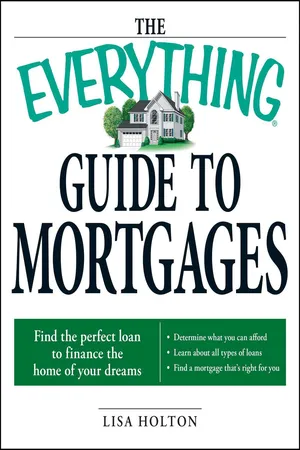![]()
CHAPTER 1
The Mortgage Business (Mortgages 101)
The first mortgages were created in the Middle Ages. For those who think these loans can be medieval instruments today, it’s important to realize that today’s conventional mortgages have not only evolved over time, they’ve transformed society in the process. Home and property loans allow Americans from all income groups—not just the rich—to eventually own a piece of land, a dwelling, or some other form of land-based property. Today’s mortgage business has enabled great wealth and, in certain cases, great failures. Here’s a look at the mortgage business and how it works.
What Is a Mortgage?
A mortgage is a loan that uses a piece of property as security for the lender. The earliest mortgages are believed to have originated in England. They granted lenders considerably more power than they have today—even though it might seem that they have plenty!
While today’s lenders have the ability to claim mortgaged property in case of default, back then, borrowers were not considered owners of the property until they had paid off their debt in full. Down payments were huge—50 percent or more. The rights of borrowers did not really begin to change until the seventeenth century. At that point, the full rights of ownership began to transition to borrowers in good standing, which is the model that exists today.
As this book was being written, a crisis in the U.S. mortgage lending market was limiting opportunities for no- and low-down payment loans, making the once-typical 20-percent-down mortgage popular again.
The mortgage interest deduction, one of the most attractive reasons for anyone to make the decision to become a homeowner, was enacted in 1913 with the creation of the federal income tax. (With the good comes the bad.) What’s interesting is that the creation of the interest deduction that year didn’t do much to actually spur home buying; it was actually intended more toward business mortgages, such as loans for storefronts and office buildings. At that point, consumers tended to save up their money and pay cash for their residences anyway—it was part of the culture.
What really put the mortgage interest deduction into wider use was the creation of the U.S. Federal Housing Administration (FHA) and the Federal National Mortgage Association (Fannie Mae), which formally began the secondary market for mortgage loan financing. When lenders had more money to lend, consumers found better reasons to borrow, and then the interest deduction started getting a workout.
Where Does Mortgage Money Come From?
If you believe what George Bailey said in It’s A Wonderful Life, lenders make mortgage loans by scraping up all the deposits they have and lending those dollars back to customers with interest. At one point in history, that was the model. However, as mortgage lending reformed after the banking collapse during the Great Depression, the government created quasi-governmental institutions to actually make a continuous, circulating market for the billions of dollars that become mortgage loans for average Americans.
Today, three primary agencies fill that role:
Federal National Mortgage Association, known as Fannie Mae
Federal Home Loan Mortgage Corporation, known as Freddie Mac
Government National Mortgage Association, known as Ginnie Mae
So what do these agencies with the funny nicknames do? Essentially, they provide a major support for the nation’s home lending system. Each serves a slightly different support function in the mortgage business. In combination, they act a bit like the stock market in that they provide a structure to keep available funds circulating throughout the mortgage system.
Fannie Mae creates financial products and services that make it possible for low-, moderate-, and middle-income families to buy homes of their own. Ginnie Mae is actually the part of the U.S. Department of Housing and Urban Development (HUD) that creates securities products made up of mortgage loans in the marketplace. Ginnie Mae then guarantees investors who buy those securities that they’ll still make their money even if the borrowers are delinquent with their mortgage payments. That keeps money flowing into the system so people can borrow to buy homes. Freddie Mac does something similar in that it buys mortgages, packages and guarantees them as securities, and then sells them to investors so money is continually pumped back into the lending system. Freddie Mac and Fannie Mae are public companies, while Ginnie Mae is part of a government agency, but all three agencies essentially compete. In doing so, they keep lending costs in check.
That’s why neighborhood lenders so rarely lend the actual money for a loan. They are the first and only truly visible step in a huge circular process that flows through individual and institutional investors and, in most cases, the three above-named entities in what will hopefully be a never-ending circle.
How Do Freddie Mac and Fannie Mae Make Money?
Freddie Mac and Fannie Mae borrow money from various lenders and then use it to buy and create portfolios of mortgage loans that they sell in the investment marketplace. Every time they create these portfolios, they mark them up to cover their business costs—and a little more for a profit, if they can get it. That’s called a spread.
When you think about it, everyone in the mortgage business has an eye on the potential for a spread, right down to the lender or mortgage broker who gets you to borrow. Fannie and Freddie look to Wall Street for their profits. Mortgage investors look to you—the homeowner—for a profit as well.
What do homeowners have their eyes on? Most watch for interest rates to fall and property values to rise so they can make a profit when they sell. Everyone (including you) is in housing to make a nickel at some point.
What Role Do Banks Play?
You may call your banker your lender, but most often, your bank is merely servicing your loan, which is to say that it handles your application and the approval process for a nice fee and then collects your money each month. The real lenders in most cases are the investors who buy securities based on your mortgage and push cash into the system for you and millions of other people to borrow. Keep in mind that anyone who originates a mortgage loan—a bank, an investment company, a mortgage broker, or banker—is in the business because it’s lucrative. So always make sure you understand what you’re paying in interest and fees. These items will be discussed later in the book.
A Closer Look at the Circle of Lending
The lender you’re applying to likely resells packages of loans—depending on the type of lender it is—either to big investors who want a piece of the action as it makes its way to Freddie, Fannie, or Ginnie, or from the agencies themselves. Financial institutions of all kinds invest in the mortgage business because historically, it’s been a fairly stable way to make money. Insurance companies, for instance, are big investors in portfolios of all kinds of loans, including mortgages.
For a good overview of the overall process of what it takes to buy a home, go online to the U.S. Department of Housing and Urban Development’s Web site. There, you will find an article entitled “Buying a Home” (at www.hud.gov/buying).
Why Do Investors Buy Mortgages?
In good economic times or bad, even when a borrower finds out he can’t pay his mortgage, there’s a pile of brick and mortar sitting on a piece of land. Property is always worth something—they’re not making any more land, as the saying goes—and consequently, buildings and property have gained value over time. Markets may slow, but a property has to be in pretty bad shape not to find a buyer at all.
Once the loans eventually make it into the big pool at Freddie, Fannie, or Ginnie, those agencies flow new funds back to your lender so they can make more loans to your friends. And so it goes.
Where to Get a Mortgage
Before 1980, there were three primary resources of home loans: commercial banks, thrifts (also known as savings and loans), and certain major credit unions. Today, there are other choices, including mortgage bankers and mortgage brokers.
Mortgage bankers are financial institutions that are chartered as banks. They can be big enough to originate and fund loans for individual customers and go directly to Freddie, Fannie, and Ginnie, who resell them and funnel money back to servicers, who start the process all over again. They may also package up loans for direct sale to other financial companies with big dollars to invest. There are certainly smaller mortgage bankers as well, but due to their size, they play mainly as intermediaries in the process.
Brokers are not lenders. They are middlemen, and they charge a fee for their services in addition to what you’ll be paying in fees to the actual lender. Make sure the cheaper solution in terms of interest rate isn’t going to cost you more.
Mortgage brokers have a job that’s similar to that of any other broker. Real estate brokers help you buy or sell a house. A stockbroker helps you buy or sell investments for your retirement plan. A mortgage broker has access to a particular universe of wholesale lenders (including mortgage bankers, insurance and finance companies, and others). Based on what those lenders are offering on a particular day, a mortgage broker’s job is to get you the best deal based on your credit history and borrowing needs. Mortgage brokers are matchmakers, and in many cases they can get you a better deal than if you went down to the local mega-bank.
How Mortgage Demographics Are Changing
Do you know what the fastest-growing group of homebuyers in the country is? It’s single women. In fact, the National Association of Realtors (NAR) reported in 2006 that one in five homebuyers was a single woman. They are buying homes in greater numbers than single men: 21 percent female versus 9 percent male.
Researchers report that women want to nest earlier than men and are increasingly getting the financial power to do it. Women are narrowing the wage gap and today are much more likely to have a college degree than men. In 2005, government data shows women who were full-time wage and salary workers had median weekly earnings of $585, or 81 percent of the $722 median for their male counterparts, up from about 63 percent in 1979.
So what about married couples? They make up 60 percent of homebuyers, according to the NAR, but that figure is sliding. Current figures are down from 70 percent only twelve years ago. Those who are getting married are doing so later. The average age of marriage in 1960 was twenty-three for American men and twenty for American women. In 2005, it was twenty-seven for men, twenty-six for women.
According to a 2002 Rutgers University study, divorced women are less likely to remarry than divorced men, and if they do remarry, they tend to wait a lot longer. That gives the...



